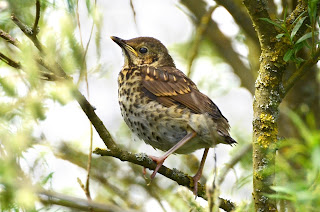But Not if the Laughing Duck can help it.
Happy New Year Dear Reader
A bit presumptuous I suppose, to imagine anyone still follows these ramblings given the BV's apparent hibernation over the last two months. Although perhaps, one or two of you may have gathered that all things HESC related, have been a bit hectic recently and may have been following events at : http://fohescnews.blogspot.co.uk/
I thought therefore, that by way of an explanation for the absence of recent posts and as my new years message to the nation(s) I should write a few words.
When I jumped ship, nearly two and half years ago, the aim was simple; dump the politics, the duplicity, the idiotic in-fighting, the long hours (rewarded with statutory indifference) and a generally unfulfilling life style, for something materially less compensatory, but spiritually more rewarding.
Recent proposals regarding changes in management and housing developments (follow link above for details) which potentially threaten the nature (in every sense of the word) of our local reserve, seemed for a while, to be conspiring to drag me back into aspects of my former life that I could do without - and have, I will admit, resulted in a few sleepless nights.
The Pond
Sleepless nights are particularly unwelcome these days, thanks to the arrival of the laughing duck on the pond which sits about 30 yards outside my bedroom window. The LD is a small dark domestic duck, who has recently turned up with a couple of colleagues and frequently expels a series of loud quacks not dissimilar from the noise made by that horrific creation, the laughing policeman. Unfortunately the LD does not sleep well either (should that be eider?)
The Laughing Duck and friend
I am certainly not complaining about my lot though. I am guessing that thousands (maybe millions) of dissatisfied UK workers, have to drag themselves into their particular satanic mill every day in order to support their families and loved ones. As financially viable retirement moves inextricably towards the preserve of septuagenarians (or outgoing BBC, NHS Trust, Local Government or Bank executives, fired for incompetence) the sentence of hard labour handed out to the rest must seem like life with no remission. But dejected workers here's a crumb of comfort.
You can apparently identify life's incompetents by their unshakable self confidence and almost permanent state of happiness. It seems, that a major factor in being totally useless, is the inability to recognise, that you have absolutely no idea what you are doing. Ignorance really does, therefore, bring bliss - so if you are unhappy with your lot, I guess it means there is a fair chance you are doing a good job. Feel better for that?
I am trying not to get too hung up on the equipment needed to take good pictures -
this one was taken with my phone and is one of my favourites of the last month.
Maybe it suggests that it is the end not the means that matters.
(Who am I kidding I still want to update my D7000 to the D7100).
Maybe it suggests that it is the end not the means that matters.
(Who am I kidding I still want to update my D7000 to the D7100).
If inclined, you can follow the various negotiations and machinations, required to try and prevent the well meaning and the well mean, from cocking up a wonderful little wildlife oasis on the north west border of Milton Keynes, on the FoHESC blog. But, I have resolved (tis the season), they will not form part of future musings under the ToaBV banner.
Afterthought - I hereby reserve the right to vent my personal spleen herein, if necessary to preserve the good name of FoHESC.
So, talking of resolutions how about this year I try for:
- More time spent watching wildlife and photography thereof
- Less time worrying about the adequacy of my equipment (photographic that is)
- Less hours spent awake listening to the laughing duck
- To be unshakably self-confident and permanently happy














































